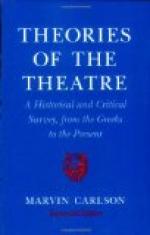Although the third and modern type of tragedy has grown to be almost exclusively the property of realistic writers, it is interesting to recall that it was first introduced into the theatre of the world by the king of the romantics. It was Victor Hugo’s Hernani, produced in 1830, which first exhibited a dramatic struggle between an individual and society at large. The hero is a bandit and an outlaw, and he is doomed to failure because of the superior power of organised society arrayed against him. So many minor victories were won at that famous premiere of Hernani that even Hugo’s followers were too excited to perceive that he had given the drama a new subject and the theatre a new theme; but this epoch-making fact may now be clearly recognised in retrospect. Hernani, and all of Victor Hugo’s subsequent dramas, dealt, however, with distant times and lands; and it was left to another great romantic, Alexander Dumas pere, to be the first to give the modern theme a modern setting. In his best play, Antony, which exhibits the struggle of a bastard to establish himself in the so-called best society, Dumas brought the discussion home to his own country and his own period. In the hands of that extremely gifted dramatist, Emile Augier, the new type of serious drama passed over into the possession of the realists, and so downward to the latter-day realistic dramatists of France and England, Germany and Scandinavia. The supreme and the most typical creative figure of the entire period is, of course, the Norwegian Henrik Ibsen, who—such is the irony of progress—despised the romantics of 1830, and frequently expressed a bitter scorn for those predecessors who discovered and developed the type of tragedy which he perfected.
III
We are now prepared to inquire more closely into the specific sort of subject which the modern social drama imposes on the dramatist. The existence of any struggle between an individual and the conventions of society presupposes that the individual is unconventional. If the hero were in accord with society, there would be no conflict of contending forces: he must therefore be one of society’s outlaws, or else there can be no play. In modern times, therefore, the serious drama has been forced to select as its leading figures men and women outcast and condemned




